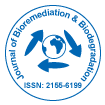Advances in Biodegradation and Bioremediation of Pesticides in Soil: Concepts, Methods, and Recent Innovations
Received Date: Nov 01, 2024 / Published Date: Nov 30, 2024
Abstract
The contamination of soil by pesticides has become a major environmental concern, as these chemicals pose risks to soil health, biodiversity, and human well-being. Conventional methods of pesticide removal, such as chemical treatments and physical extraction, often present environmental challenges, inefficiency, and high costs. Biodegradation and bioremediation have emerged as sustainable, cost-effective alternatives to mitigate pesticide pollution in soils. These methods utilize the natural abilities of microorganisms, plants, and enzymes to degrade, transform, or immobilize pesticide residues. Recent advancements in bioremediation techniques have significantly enhanced the efficiency of pesticide removal, with novel strategies such as genetically engineered microorganisms, microbial consortia, and phytoremediation showing promising results. This review highlights the latest developments in biodegradation and bioremediation methods, emphasizing the underlying mechanisms, novel approaches, and the challenges that still exist in managing pesticide contamination in soils. The article discusses the potential of integrated bioremediation strategies and explores future directions to improve the practical application of these technologies in large-scale remediation efforts.
Share This Article
Recommended Journals
Open Access Journals
Article Tools
Article Usage
- Total views: 312
- [From(publication date): 0-0 - Apr 04, 2025]
- Breakdown by view type
- HTML page views: 160
- PDF downloads: 152
